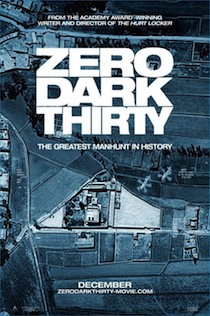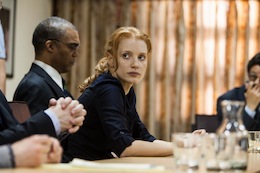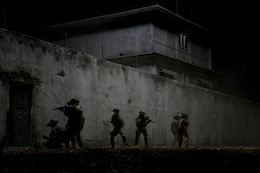 Director Kathryn Bigelow and writer Mark Boal return to hard-nosed military drama with Zero Dark Thirty, a film that tells a dramatized version of the 10-year manhunt for Osama bin Laden. That’s the film on paper. On-screen, Zero Dark Thirty recounts the fear, uncertainty, frustration and obsession that characterized the last decade of the War On Terror. The film does an amazing job of dealing with its subjects and subject matter even-handedly, concerning itself with the details (real and embellished for the film) that led to discovering bin Laden’s whereabouts.
Director Kathryn Bigelow and writer Mark Boal return to hard-nosed military drama with Zero Dark Thirty, a film that tells a dramatized version of the 10-year manhunt for Osama bin Laden. That’s the film on paper. On-screen, Zero Dark Thirty recounts the fear, uncertainty, frustration and obsession that characterized the last decade of the War On Terror. The film does an amazing job of dealing with its subjects and subject matter even-handedly, concerning itself with the details (real and embellished for the film) that led to discovering bin Laden’s whereabouts.
Beginning with one of the most minimalist and affecting recounts of 9/11, the film soon introduces us to Maya played by Jessica Chastain, a young CIA operative attending an enhanced interrogation session. The way the Bigelow addresses these techniques, and more importantly, the information gleaned from them has drawn a lot of attention from critics and Washington, and may have cost her a much-deserved Oscar nomination. Ironically, the film’s depiction of torture is most shocking because it is undramatized and matter-of-fact. It’s disturbingly clinical and rightly so.
As the next decade of false starts, missed opportunities and junk intel unfold, Maya begins to become obsessed with finding bin Laden. As a stand-in for the audience, finding him gives sense and closure to 9/11, to Iraq, to Afghanistan and to the last decade of geo-political theatre. And while that’s never expressly said (Bigelow and Boal are too smart to do something like that), her search becomes our search and it isn’t long before the audience is putting their own perspective on what the manhunt means.
Boal’s screenplay is remarkable in its economy of storytelling and clarity. There is a huge cast of supporting players, but he wisely places focus solely on Chastain’s character. Shouldering the entire burden of this story would be daunting for any actress, but Chastain is never better than she is here. Her performance is metered and believable, full of the kind of shaky poise and volatility many actors struggle to balance. It’s remarkable to think what lies ahead for her career.
At times the film’s supporting cast can be somewhat distracting, as Bigelow chose to populate with recognizable TV and film actors. This is typical of most films, but one of the things that made her last film The Hurt Locker so compelling was the absence of recognizable faces, save a few cameos. It forced the audience to focus on the story more than the characters. Zero Dark Thirty is compelling enough on it’s own merits that the casting choice never impede the film, but if there’s a nit to be picked, that’s the only one.
The raid on the Abbottabad compound will go down as one of Bigelow’s crowning achievements in filmmaking and does an excellent job of summing up the power of Zero Dark Thirty. We as an audience know how the events played out. We know that he was killed and we know that there was no loss of American life. But even with that knowledge, Bigelow and Boal are able to create a scene that is intense and gripping for every frame. She uses several cinematic mechanisms to accomplish this, namely handheld cameras and the absence of a soundtrack, but there’s a real economy of filmmaking and assuredness in the editing, choice of camera placement and actor choreography that make it masterful.
Zero Dark Thirty is the rare film that treats both its audience and its subject matter intelligently. In a lesser director or writer’s hands, the story could have been made-for-TV caliber or jingoistic or propagandistic. It could have trivialized the mistakes and embellished the victories and canonized everyone involved. But it doesn’t. What it does do is tell a story closely connected to real events with an astounding attention to detail and in the process touch on true and real.






{ 12 comments }
Great review, Trevan! Couldn’t have said it better myself.
I found it to be pretty lacking. It’s a very fictionalized version of events and nearly all of the “dramatic” choices made were poor and usually unnecessary. Much like Saving Private Ryan, it essentially masks it’s near cartoonish characters in well executed design and cinematography.
I wouldn’t call the characters cartoonish–I thought they did a great job drawing them efficiently while moving the investigation forward. The device of her writing on the window bugged me at first, but I know they needed a ‘ticking clock’ mechanism to ramp up tension before the raid, and it played better the 2nd time for me.
They are pretty much caricatures, in my opinion. Especially the SEALs who are given short shrift. They are made to be like some sort of superhero jocks that just go do what needs to be done at a moments notice vs the highly trained, intelligent men they are. It doesn’t portray or honor the months of training and intel analysis the SEALs did on that mission. Those things were huge elements of the mission’s success. The Chastain character is one note which to me is all the more troublesome considering she is a composite of many people. They start the movie telling you what a cold blooded super analyst she is but they never really back it up other than displaying her perservance which doesn’t sell how they have other characters describe her. The window writing was idiotic but even more so was the final scene on the C-130. Complete fiction and unrealistic to boot. I’m done with the descriptions of Bigelow and Boal movies as smart/gritty/realistic just because they use a bunch of handicam and use washed out colors. I think ZDT and the Hurt Locker have good performances and they look good but I don’t go for “this is how it is/was” stuff that seems to especially accompany those films. If Bigelow’s movies are “realistic” then Trouble with the Curve is an accurate portrayal of baseball and scouting.
The final scene on the C-130 was one of my favorites of the entire film. It conveys all of the exhaustion and conflicted feelings of Maya, who is our stand-in, and has been so deeply focused on one thing. That’s the moment in the film where we are able to step outside the procedural and the siege and reflect on what this hunt means for the country and was it worth it.
It was an interesting choice to humanize the SEALs but not focus at all on their training. 2 reasons for that probably: economy of story (it’s already almost 2 hours in at that point) and the POV of Maya wouldn’t allow it. It doesn’t make their actions any less heroic. If anything, the tense achievement of the raid on film makes you appreciate their commitment and problem-solving skills.
Here are my problems with final scene. The idea of her having the plane to herself and the “where do you want to go?” thing was absolutely ludicrous and really unnecessary. No way in hell one of our planes leaves Afghanistan or any theater without a flight plan. It’s one thing if something so silly happens in a Michael Bay movie but in a Bigelow/Boal movie with all of their, the studios, and critics marketing and trumpeting of the realism of their films, it’s all the more dumb. Having read the Mark Owen book, I also know that the woman who Maya is mostly based on was on the return flight home with many of the SEALs. Instead of emphasizing the team of intel agents and analysts and the military, the filmmakers opt to remove that element out completely. There could still be her moment of exhaustion and reflection (the real woman was crying to herself on the plane) and still better reflect the reality. That’s the biggest “dramatic license”-type choice that bugged me.
I get the time/editing element to the SEALs part of the film but I think that could have been addressed too in two very short scenes displaying the training and planning or a few lines of dialogue could have been said. How about cutting one of the many (unsupported) references to Maya’s being so valued, coldblooded, etc. and pop something about the SEALs in?
The raid itself is really well done despite the big missing element of there having been a guest house that had to be raided simultaneously. Despite all of my issues with ZDT and the Hurt Locker, I did enjoy both movies. Overall, both films have great performances, great cinematography and are edited really well. I just think people need to cool it on all the “realism”-related praise when it comes to the stories being told. The Bigelow stuff to me is much closer to Saving Private Ryan Hollywoodized storytelling versus the Black Hawk Down approach.
I really think you are clutching at straws there with the inaccuracies. It is a film after all and it doesn’t pretend to be a documentary. At the end of the day does it really matter if the seals were on the plane with her at the end. No. The point of the scene was to show that there were still questions left after the raid and everything wasn’t magically solved.
I don’t think that showing training would have added much to the movie either, we know that they are highly trained and we get to see the effects of the hard work on screen. What would you have preferred, some training montage that added to the run time and ruined pacing?
I think the big takeaway is not that all the moments depicted on film are 100% accurate, it is a work of fiction ultimately. But the film makers have done their research and have utilised a composite of their workings to construct a narrative, based on the events, that changes things just enough here and there to make it work on screen. The important thing is that it feels genuine if not 100% accurate, manages to balance character, tension and dense plotting and does not lead you down a certain part and tell you what to think about the events.
I 100% agree with Chad (and then some). This is far from the best picture of the year. I don’t even believe it deserves a place at the table. Its only attributes are allowing for an otherwise unavailable voyeuristic look into a mission that wasn’t meant for civilian eyes. This film shrewdly capitalizes on the desire for a visceral experience to compliment the sense of closure that came with UBL’s death. The editorial statement that ends the film, that America doesn’t know who it is anymore without UBL to define itself against, is simple and wrong-minded. I wouldn’t say it was a complete waste of time (I didn’t want the time back), but it is decidedly mediocre. And I know I was meant to be, but was I ever bored the first hour and a half of this film.
So did you just go to have you already preconceived notions affirmed? Because you had to have known that this was what this movie was about and that they would show the raid.
I’m honestly not sure what you were expecting.
I am so glad to hear a couple of other people out there that feel the same way I do. I came out of the screening feeling completely underwhelmed. There was so much hype that I was expecting to be blown away. It was way to long on top of everything else mentioned above. If I had to a vote, Argo is definitely the better based on a true story CIA drama of the year.
No Argo is definitely not. It is the more straightforward, hollywoodified movie that misses the point, tells you what to think and is far less genuine in feel. Zero Dark Thirty leaves you with questions that don’t have easy answers, and builds actual tension, while subtly and slowly developing character, instead of focusing on plot points and pulling every cheap movie trick in the book to build fake tension,
I saw the film for the first time last night, and thoroughly enjoyed it. Bigelow’s direction of showing it from a CIA agents perspective is what interested me the most. We have already seen/heard about the SEALS involvement in the raid for the last year, this doesn’t humanize or takeaway from the job that they did, for it was an outstanding one. But the general population has never been exposed to how much actual hard work our intelligence agencies had to put in just to get baby steps of information on UBL and his hierarchy. For someone who was just 11 years old when 9/11 happened, not completely understanding the magnitude of those events. And then growing up around our country involved in war where the one we blamed for that terrible day, we couldn’t catch for 10 years, it was hard to understand why. This film was able to explain that.
Comments on this entry are closed.